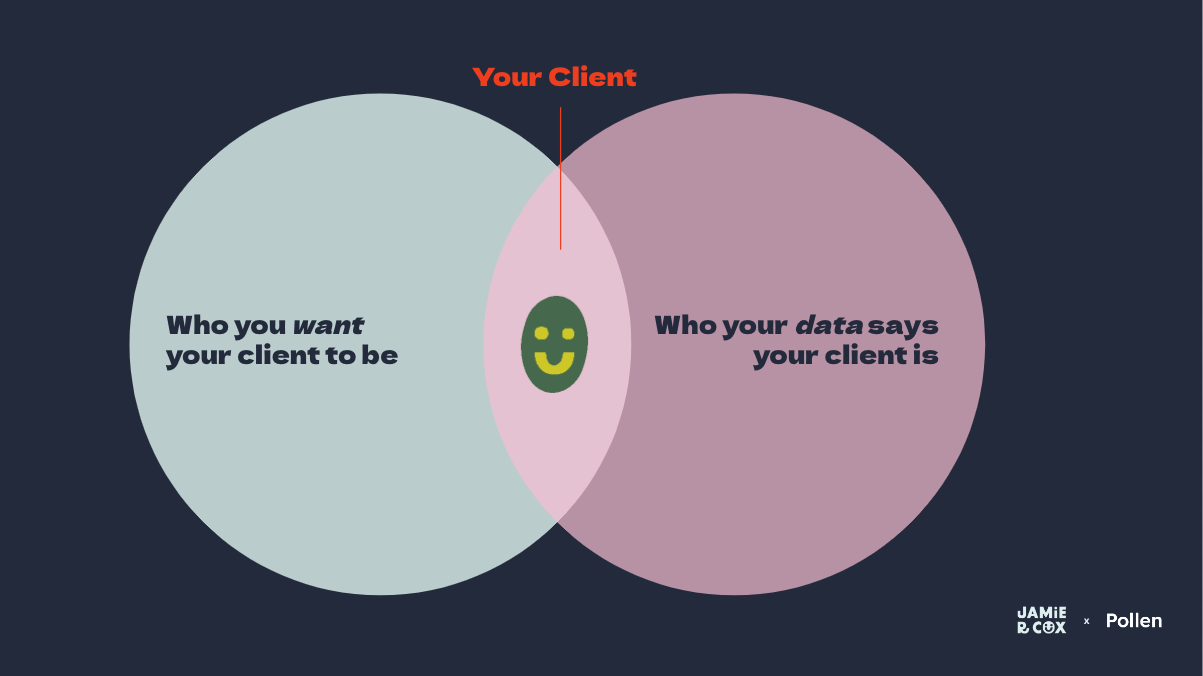Write Homepage Copy
A clear and compelling homepage is critical for converting curious prospects into warm leads. It might be tempting to build your homepage with a linear story: here’s me, here’s what I do, here’s why I do it, here are examples of how good I am at it, hit me up!
However, a more effective approach is to restructure the contents of your homepage to appeal to clients, starting with a problem statement and ending with your story. This approach can showcase more directly how you will meet clients’ needs and the benefits of working with you.
Your hero copy is your opening gambit: it sets the tone for everything that follows. This copy should speak directly to how you solve something for your ideal customer. Make your prospective customers feel seen here—you know what they need, and you deliver a transformative solution.
This above-the-fold section should include:
- A headline: Clearly state the primary benefit or solution you offer.
- A subheadline: Provide a brief supporting statement or explanation.
- A call to action: Include a clear and compelling CTA that directs visitors to take the desired action.
This may sound counter-intuitive at first, but when writing this copy, don’t make yourself the focus. Instead, orient the narrative around who’s looking—and what they’re looking for. This advice applies to all of your homepage copy, but especially your hero copy.
In “The StoryBrand Framework,” bestselling author Donald Miller makes this point with the advice to place your target audience or client at the center of your marketing story. The audience is the hero, and you're their guide: your expertise exists in the context of their problems or challenges and helps create a clear path toward solving their goals.
Embracing that external perspective allows someone to land on your site and not just see you and your work but, critically, see themselves. If they believe that you truly understand their problem and see proof that you can solve it—they’re in.
As an example from my own brand:
- The headline is “Branding Made Fun and Friendly”
- The subheadline shares that I offer brand strategy services.
- The call to action is to Learn More

Placing an About section near the bottom of the homepage is a reminder that you’re not the center of attention but the guide leading the experience. If you prefer, you could include a link to a longer form bio or resume.
Capture the essence of your experience and unique perspective with:
- A headline: 3-5 words that encapsulate your professional personality
- Body copy: 3-5 sentences of body copy that mention your experience, how you think about your work, and what clients love about working with you. This can be short and sweet and link to another page that gives a more detailed resume or qualifications.
Even if you’ve already placed an initial call-to-action alongside your hero copy, there should be many opportunities for a client to engage as they move through your homepage. The key is placing them at the correct intervals—like immediately after reading a succinct analysis of the problem they face and your proven experience in solving it, perhaps?
This might look like:
- A headline: 3-5 words of action for your potential client to start your process (i.e., contact me).
- A subheadline: Provide context as to why they would want to, reiterating what they’ve learned from prior sections.
- The call-to-action: A button or hyperlinked text that includes a clear and compelling CTA that directs visitors to take the desired action.
Remember: building opportunities for conversion into your homepage is not just about what works best for you, but also what works best for your potential clients. Prompting visitors to book a call and linking out to your Calendly might work for some audiences, but some (lookin’ at you, millennials) might prefer to submit a contact form over speaking in person. Providing different touchpoints for different customers increases your chances of conversion.
A clear and compelling homepage is critical for converting curious prospects into warm leads. It might be tempting to build your homepage with a linear story: here’s me, here’s what I do, here’s why I do it, here are examples of how good I am at it, hit me up!
However, a more effective approach is to restructure the contents of your homepage to appeal to clients, starting with a problem statement and ending with your story. This approach can showcase more directly how you will meet clients’ needs and the benefits of working with you.
The features section allows you the space to get into the nitty-gritty of your area of expertise. If you're a content strategist, for example, you might dive into what content strategy can do for them or the benefits they'll see in different phases of a strategy project. Maybe part of that's getting organized, maybe part of it is being more consistent. You want to highlight the benefits of investing in a service like yours.
You may choose to lead with one main benefit or a matrix of many, depending on what you offer. Either way, speak to it with:
- A headline: 3-5 words showcasing the features of your process and service so people know what they can expect to gain when they work with you.
- Body copy: 3-5 sentences that showcase the benefits your client will receive from working with you. What is the outcome? What transformation will they experience?
Because your clients might be searching for your services or expertise on Google, here’s an important reminder: your homepage copy impacts your Google ranking, which impacts how easy it is for your clients to find you. Think about what your audience might be searching for that’s relevant to your offering, and use a keyword research tool to vet your instincts. Then, incorporate those keywords into your homepage headers and body copy to improve your chance of appearing in search results. Expert guidance can help—consider tapping an SEO expert before you begin writing and implementing your homepage copy
Homepage copy is one of those things that feels like it should be easier than it is. You know what you’re about and what you want to do in the world, but every time you try to capture it, it reads like a jargon-packed elevator pitch. Or maybe you swing to the other end of the spectrum and wind up with something so abstract it lacks meaning.
If you’re finding yourself stuck, or if you’ve shared your copy with a few trusted advisors or clients and it’s not landing, these are situations when it’s worth it to hire a professional writer. If you don’t have the budget to hire one, consider trading your services with someone in your network.
Leading with the problem isn’t about being negative–it's a critical context for the solutions you offer. Try to be specific and direct with a brief section about what problem or problems you solve.
Format it like this:
- A headline: One sentence that clearly describes the problem your client is facing.
- Body copy: 1-2 sentences that present you as an independent consultant or the service you provide as the solution to your client’s problem.
- List of key benefits: Highlight three key benefits of your solution, captured in a handful of words—extra points if you can get it in two to three—each.
Below is an example of how I’ve put this into practice on my website. This is just to provide an example–you may have a very different approach in terms of design, tone of voice, and layout.

independent consulting business to the next level.







